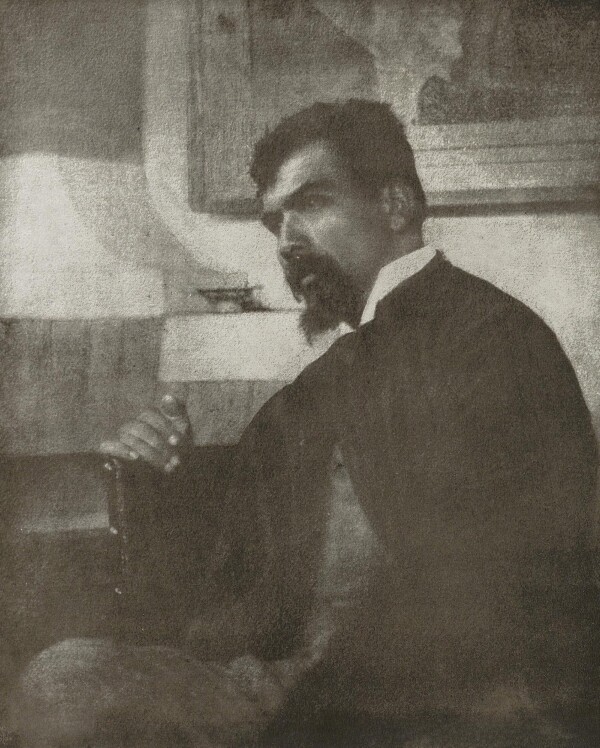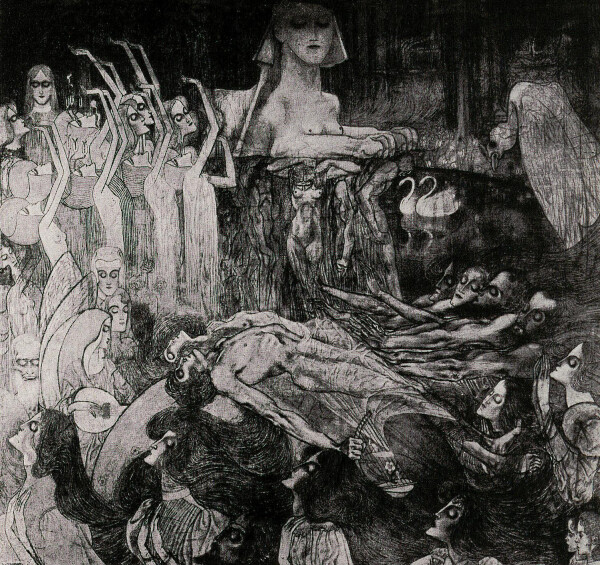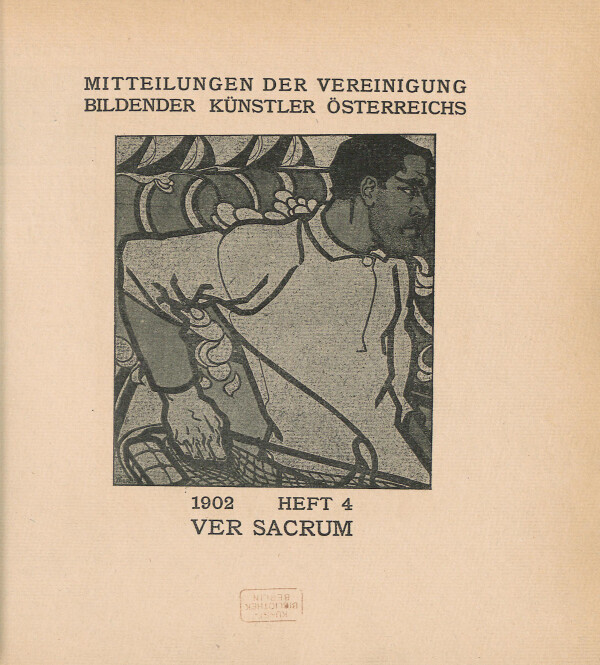Jan Toorop

Jan Toorop photographed by Friedrich Victor Spitzer, around 1903, in: Deutsche Kunst und Dekoration, Band 12 (1903).
© Klimt Foundation, Vienna

Jan Toorop: De Sphinx, 1892, in: Deutsche Kunst und Dekoration, Band 5 (1899).
© Heidelberg University Library

Cover of the Ver Sacrum dedicated to Jan Toorop, in: Vereinigung bildender KünstlerInnen Wiener Secession (Hg.): Ver Sacrum. Mitteilungen der Vereinigung bildender Künstler Österreichs, 5. Jg., Heft 4 (1902).
© Heidelberg University Library
At the turn of the century, the Dutch painter and graphic artist Jan Toorop was one of the most important and versatile exponents of Symbolism. His painting style and imaginative works were a major source of inspiration for Gustav Klimt’s work on the Beethoven Frieze.
Jan Toorop was born on the island of Java in 1858. He spent his childhood in the Dutch Indies before his parents sent him to the Netherlands. In 1880, Toorop began studying at the Rijksakademie van beeldende kunsten in Amsterdam and at the École des Beaux-Arts in Brussels. In 1885 he was the only Dutch artist to join the newly founded Belgian avant-garde association Les Vingt (Les XX). During this time, Toorop met such artists as Fernand Khnopff and James Abbott McNeill Whistler, whom he visited while staying in Great Britain.
From 1890 on, he lived in the Netherlands again with his wife Annie, whom he had married four years earlier. Over the next few years, Toorop maintained close contacts with the poetry and literary scene, which would have a decisive influence on his Symbolist works – in which he increasingly explored the themes of (female) sensuality and death. Important drawings such as De drie bruiden [The Three Brides] (1892/93, Kröller-Müller Museum, Otterlo) and De Sphinx (Les Ames autour de Sphinx) [The Sphinx (Souls Around the Sphinx)] (1892–1897, Kunstmuseum den Haag) were created during this period.
“For this Symbolist Toorop Is a Symbol Himself”
In 1900, several works by Jan Toorop premiered in Vienna, at the Vienna Secession’s 7th Exhibition. However, Toorop’s painting De nieuwe generatie [The New Generation] (1892, Museum Boijmans Van Beuningen, Rotterdam) was probably one of the most controversial contributions to this exhibition alongside Klimt’s Philosophy (1900–1907, destroyed by fire at Immendorf Castle in 1945).
Two years later, the “XII. Ausstellung der Vereinigung bildender Künstler Österreichs” [“12th Exhibition of the Association of Austrian Artists”] presented a total of 23 works by Jan Toorop. In addition, the Secessionists dedicated the fourth issue of their magazine Ver Sacrum to him in the spring of 1902. The Austrian writer Ludwig Hevesi honored him with an article that was several pages long:
“[A]nd Toorop draws pictures one can only understand in a dream, but in front of which, when awake, one almost certainly feels to have understood them when dreaming. There is religion in Toorop’s pictures. Who has ever organized a Toorop exhibition will know.”
Interestingly, the article also mentions Gustav Klimt. Hevesi describes Toorop’s artistic bond to the cosmopolitan city of Vienna and to the painter Klimt himself as follows:
“For long enough it was said: Toorop is not an artist for Vienna. Why not? Isn’t Vienna Klimt’s city? A Viennese art lover who recently visited him in Katwijk reported: His first word was Klimt. For him, Vienna and Klimt are synonymous. He already longs for Vienna and Klimt, and he will come.”
From Symbolism to Religious Art
From 1905 until the end of his life, Toorop was increasingly preoccupied with religious and mystical motifs. This was probably due to his conversion to Catholicism, his severe illness, and the outbreak of World War I. He died in the Dutch city of The Hague in 1928.
Literature and sources
- Biografisch Woordenboek van Nederland. Jan Toorop. www.resources.huygens.knaw.nl/toorop (03/25/2020).
- Ludwig Hevesi: Acht Jahre Sezession (März 1897–Juni 1905). Kritik – Polemik – Chronik, Vienna 1906, S. 239-243, S. 375-379.
- Der Tag, 08.03.1928, S. 4.
- Neue Freie Presse, 04.03.1928, S. 13.
- Ludwig Hevesi: Jan Toorop, in: Vereinigung bildender KünstlerInnen Wiener Secession (Hg.): Ver Sacrum. Mitteilungen der Vereinigung bildender Künstler Österreichs, 5. Jg., Heft 4 (1902), S. 65-76.
- Hans Vollmer (Hg.): Allgemeines Lexikon der Bildenden Künstler von der Antike bis zur Gegenwart. Begründet von Ulrich Thieme und Felix Becker, Band XXXIII, Leipzig 1939, S. 280.

